|
This year, through a confluence of unexpected but welcome events, I was able to teach an "alternate route" teacher preparatory program through the Essex County Provisional Teacher Training Program (ECPTTP) in Montclair, New Jersey. The following is a (slightly modified) copy of my parting letter to my adult students upon their completion of the new EdTPA national requirements and graduation from the program. These students are all in the classroom teaching already, but this program's completion ensures the receipt of their standard teaching certificate. Dear Friends,
In the words of the late Jerry Garcia, "What a long, strange trip it's been." I am so proud of you all for what you have accomplished over the last two years. As I've mentioned a few times before, taking on this position was, and still is, a daunting task. You welcomed me with grace and kindness, and I am so grateful for that. In my day job as a high school English teacher, this time of year reminds me of how often, and how much, we focus on the least important parts of our students' lives and learning. These final few days of the school year, a time that should be spent connecting with our students, is far too often bogged down with Sisyphean box-checking, scolding demands for missing assignments, and the steady hum of directionless anxiety. My simple request of you, as you go into these last few days of the school year, is to remember that more than the equations, vocabulary, formulas, and historic dates, your students will remember the relationships they formed with you. Make those relationships great. It would be beyond cliched to say that your students are lucky to have you, but they are. There are many, many reasons not to go into education, and you have most likely been confronted by several of them, but there is always, will always be one big reason to teach: you get to help children become themselves. That is a heavy responsibility, but one at which I know you will succeed. As you are undoubtedly sick of hearing me say, teaching is not a job, or a career, or a gig, but a practice, and like any practice, it demands reflection, curiosity, and humility. You will mess up. Frequently. Sometimes so badly that you don't think you'll be able to show up the next day. Show up. Learn from these mistakes; be humble enough to accept that you don't know everything and confident enough to know you can get better. Share your failures with your students so they know that all people, even and especially those they respect the most, mess up all the time. That is a great gift you get to share with those that need it the most. Above all else, I ask you to retain the sense of childish wonder that your best teachers brought out of you. I often tell my students that people want to be around interesting people, and the only way to be interesting is to be interested. I encourage you to always remain interested, not just in your subject, but, to paraphrase the writer James Herriot, in "all things great and small," especially those things that scare, confuse, or intimidate you. While reading Macbeth with my students this year, I was struck by this seemingly insignificant line spoken by Duncan, the King of Scotland, to his countryman Macbeth: "I have begun to plant thee, and will labor to make thee full of growing." This, in closing, is what we are tasked with: nurturing our students, (even and especially those prejudged as "bad seeds") to help them grow fully. It's a daunting, complicated task, for certain. It's also a lot of fun. You are ready. Go do great things.
2 Comments
This post originally appeared on Corwin Connect in September 2018. You can access the original here. As I begin my twelfth year as a teacher, I find myself reflecting on the more absurd aspects of the profession—those practices that are continually implemented despite their demonstrable ineffectiveness—and how they are perhaps most prevalent in the teaching of literacy. The English Language Arts experience is, in many ways, a tale of two classrooms: while we often say that we prioritize the process of literacy, the vast majority of our assessments emphasize the product of reading. Ultimately, and despite our best intentions, we are “teaching books” instead of teaching reading, an approach that often conceals significant developmental deficits among our students beneath the slick veneer of presentations, projects, and papers.
To be fair, the “teaching books” approach is historically how the vast majority of English Language Arts curricula have been, and are presently, designed. There’s just something so orderly, so comforting, about it, isn’t there? The unit starts at the beginning of the novel, hits its stride around chapter 9, and builds to its arts-and-crafts crescendo as the conflict resolves and the protagonist learns a valuable lesson about growing up and what it means to be family. “It’s how I learned, it’s worked for me for the past twenty years, and gosh darnit, it’s how my students are going to read The Great Gatsby!” you say, possibly to yourself, possibly to your cat. And again, I can’t blame you; we feel a weighty burden every time we approach a text with our students: “This is their one chance to read Catcher in the Rye, or Hamlet, or 1984,” we reason, “and who am I to compromise that?” To do anything less than the book, the whole book, and nothing but the book, seems a disservice to both student and profession. And with that thought, the absurdity of the situation rears its illogical head. Since we’re “teaching the book”, our students know what we’re looking for: plot, primarily, with some character analysis and theme study thrown in. They no longer have to read the book at all, just act as if they did, and provide the appropriate literary elements when called upon. Sparknotes, older siblings, and Google Docs cheat-sheets will meet these needs with nary a page of the novel turned. They aced the test, nailed the discussion, and wowed you with the quote selection in their essay, so they must have read. But they didn’t, and it’s because the priority in this book-based approach, either explicitly or implicitly, is not reading comprehension, engagement, or fluency, but trivia. Instead, I propose an approach less adherent to the way things have always been done and more in line with developing literacy skills, an approach that focuses primarily on the process of literacy development rather than merely the completion of texts. In short, a classroom that prioritizes the act, rather than the result, of reading. Let’s explore a seminal high school text, Harper Lee’s To Kill A Mockingbird, through this lens. This book, to be blunt, is thick, and its physical introduction to a classroom induces a panic among students typically reserved for when the Fortnite servers go down. An absurd approach would be to assume that, since the book is on the curriculum (and the curriculum was ostensibly designed with the students’ competencies in mind,) students will be able to complete the assigned readings, the proof of which will manifest through class assessments. The reality of the situation is that a significant number of students, finding the text too challenging, confusing, or time-consuming, will “hack” the reading using online summary sites (Sparknotes, Shmoop, etc.) in order to keep their heads above water. This “Whole Novel, Whole Time” approach may have been designed for learning, but it elicits sheer student survival mode. Instead, a classroom that prioritizes reading rather than having read will engage in the reading live, in class. (I’m vehemently against homework in general, and reading homework in particular, for many reasons, not the least of which is its tendency to obscure symptoms of poor literacy from teachers.) Of course, this class could never cover all four hundred pages of Mockingbird, so why pretend? Perhaps students only read chapter one. Or chapter fourteen. Maybe only excerpts of Lee’s narration. Or just her choices with dialogue. Maybe (and this tends to be my favorite approach as of late) the class arrives at a random page (using an online number randomizer, for example) and works through that page together. The choices are unlimited when the teacher removes the expectation of covering the whole novel. The upshot of this framework, when looked at as a year-long approach, is a significant increase in the number of texts covered, marked growth in students’ reading comprehension and recognition of authorial strategies and patterns, a greater appreciation of writing as craft (books such as Roy Peter Clark’s The Art of X-Ray Reading dive into this further), and, perhaps most tellingly, a decrease in reading avoidance strategies (i.e. “Sparknoting”) among students. Of course, many educators will balk at the notion of not teaching a novel in whole as too great of a compromise for their students. While this is an understandable concern, it is based more out of an assumption of what their students are experiencing when “taught a book” and not the reality of the approach. Those students, by and large, simply aren’t reading whole texts any more than mine; they’re just operating under an approach that assumes they are. We must acknowledge the absurdity of this practice and focus instead on the act of reading, rather than the seductive, but erroneous, belief in our students having read. I encourage you, in your classes and with your students, to reflect upon the absurdity of an approach that gives children books they will not read in the name of How We’ve Always Done Things. In ending this dangerous charade, and shifting to critical in-class literacy development, we can focus instead on helping our students grow by embracing the process, rather than product, of reading.  You’re not fooling me, stock photo...you’re not fooling anyone. You’re not fooling me, stock photo...you’re not fooling anyone. Note: This post has been cross-blogged on the Conference on English Leadership (CEL)'s blog All English teachers are familiar with that gnawing feeling: the paranoid scan of an essay, the neurotic parsing of a student’s response, the subsequent guilt for even daring the thought…this is good, you reflect, perhaps too good. The creeping suspicion of Fake Reading. My brilliant professional colleague Gerard Dawson writes eloquently on this issue on his own blog gerarddawson.org, specifically in his OED-esque breakdown of the term, in which he writes that it is primarily defined as “[a] student’s process of completing required assignments, including quizzes, essays, discussions, and other activities, in order to achieve a passing grade but without reading a required text.” His full post is an engaging, and harrowing, primer on the condition as it exists today, and I encourage all to read (print, laminate, etch in granite, etc.) his full overview. My post today seeks to build on his work and pick up where it leaves off: namely, by presenting a structural framework of philosophy, application, and assessment to not only hinder Fake Reading but hopefully, silence its seductive call altogether. We must first, unfortunately, accept an inconvenient truth: the vast majority of our students are either 1. not comprehending what they’re reading, or 2. not reading, period. Heresy? Blasphemy? Inconceivable, you say? Consider this: If we define reading, let alone academic reading, as the ability to process text and absorb its meaning, and we acknowledge, culturally, scientifically, and anecdotally, that students consistently struggle with this skill, this truth becomes more apparent. How, then, are they so thoroughly able to demonstrate plot understanding, thematic analysis, and character deconstruction in writing and speech? Dawson again touches on this in his post, but to me, this bears elaboration here: although we may know this personally, our reading instructional model still prioritizes recognition and analysis of the “Important Parts” of fiction: mostly plot, characterization, theme, and setting. Furthermore, the slow-turning wheel of text approval in school districts and a reluctance to move away from touchstone novels reinforces the free-market need for a way to circumvent the actual heavy lifting of reading a whole book. Enter SparkNotes and Shmoop, and their less-savory cousins GradeSaver, eNotes, and others. This is not to say that these sources cannot provide helpful tools and information; in fact, I recently leaned heavily on Shmoop’s line-by-line breakdown of Robert Burns’ “To a Mouse,” prior to a class discussion, but our students, by and large, are not using these sources as confirmation, or counterpoint, but rather as a convenient replacement for reading. To put this in terms that speak more closely to my heart: we want students to make a pizza from scratch, yet our assessments ask students to simply hand us a pizza; they then call Domino’s. Admittedly, sometimes, we go somewhat further and ask them to tell us how the pizza was made, but that can be done without the student having rolled out the dough in the first place. (See?) Ultimately, the process is assumed instead of demonstrated, and the product is taken as proof of the process. Honestly, can we really blame them? Our students experience more stress today than 1950s child psychiatric patients, have more access to digital resources than at any time in human history, and are presently caught in the ideological/political/cultural tug-of-war regarding homework, sacrificing sleep in the process. They simply and deftly adapt using a basic cost/benefit equation: if they can get the grade they want without having to commit hours to actually reading the book, freeing up valuable time to study for their other classes in the process, why wouldn’t they? We as English educators frequently fall victim to the biased view that, if given an interesting enough text, students will abandon past unscrupulous practices and dive headlong into a world of magic and discovery. This is well-intentioned, but ultimately self-defeating, as it can unintentionally encourage further text avoidance and instill overconfidence in a teaching approach that still prioritizes “Googleable” analysis. The sad truth is this: we have inherited a transactional culture of education; our students respond accordingly. It’s not that they don’t want to read, in an objective sense, or that they don’t see the inherent value of texts, but rather that when push comes to shove, Fake Reading negatively affects their grade less than faking required assignments in other courses, and in many cases, doesn’t hurt them, gradewise, at all. If we don’t address the structural components of instruction and assessment that allow, albeit tacitly, the circumventing of authentic reading, this trend will undoubtedly continue, and most likely increase, as resources become more thorough and ubiquitous. To be fair, I have been, and most likely am still being, fooled by this approach. (To those brave enough, Google the name of a novel you presently teach and “analysis” or “themes” and see what comes up.) The remedy, as I see it, is to fully acknowledge that the emperor is naked and adjust our reading expectations to render these alternate strategies pointless before they’re even considered. WHO IS AT RISK? There are, in my mind, ultimately three categories into which students fall regarding reading: Fake Readers, School Readers, and Fluent Readers. Again, Dawson does an excellent job isolating some of the symptoms of Fake Reading, but in a nutshell:
Based on my experience in the classroom, I would wager that the middle category of School Readers is the most substantial, and by a wide margin. Frankly, our students are situated in a culture that vehemently discourages “wrong answers”- why risk it on an organic, and potentially incorrect, analysis? As the great digital hero Link was famously, and repetitively, warned, “It’s dangerous to go alone!” These categories are depressingly static if left unaddressed. The student who Fake Reads one book will fake read most, if not all, assigned texts, and we must face the stark realization that there are students who emerge from high school without having authentically read any texts. THE FIRST STEP IS A DOOZY: MOVING AWAY FROM “TEACHING THE BOOK” Admittedly, I believe this is the most difficult task facing any English teacher who hopes to destroy Fake Reading. Teaching “the whole book” just feels...right (right?) This is how many of us learned to structure units of study in our undergraduate and preparatory programs; this is how our mentor teachers masterfully demonstrated their craft; this is how Michelle Pfeiffer, Hilary Swank, and Cameron Diaz do it in the movie-versions of our jobs, which are, of course, strikingly accurate portrayals of a nuanced profession. How can you even teach literature, we reason, without teaching the book? The reality, of course, is that in teaching the whole text, we are almost always emphasizing, consciously or not, values that correspond to Fake Reading approaches: forward progress is paramount (“get to page X, chapter Y, the end of the book by the last week of Z…”); independent, unsupervised reading is essential to cover all that ground; all students are prepared to read the same text; recall and analysis of conflict, theme, and characterization are the essential checkpoints of reading comprehension. Not to belabor the point, but these values can all be demonstrated and validated through the aforementioned Fake Reading strategies, and students know it! There is also a bit of ego-death associated with this transition away from assigning the whole text. There are certain books we love to teach, plain and simple. (If left to my baser instincts, I would go full Charlie Heston if someone tried to take The Stranger from me.) But this self-identification can often blind from concrete instructional problems: the more we love a certain text, the more likely we are to didactically expound on its brilliance to our students: we essentially become the SparkNotes ourselves. Why read the book, students rightfully wonder, if Morone is just going to tell us why Meursault represents the definition of the Absurd rebel? In fact, many of my students have resorted to simply shouting “existentialism!” when they run out of ideas, regardless of topic; in my weaker moments, it works. Last year, I finally had enough with the whole-book approach charade my Freshmen students and I were acting out, wherein I ask them to read the 400-page To Kill A Mockingbird in May, knowing full well they struggled reading Of Mice and Men in February, simply because of a combination of “it’s on the curriculum” and “I mean, come on, it’s Mockingbird! They have to read Mockingbird!” To be blunt: assigning a book to check an “important” text off a hypothetical Literary Bucket List, or to avoid the wrath and scorn of Harold Bloom, is flawed practice, and I was guilty as sin; in doing so, we ironically create within our students a tortured or guilt-laden mental association with this book. It should be noted that many of these students had acknowledged to me that they rarely, if ever, read required texts for class. One October exchange went like this: Student: “Morone, don’t be mad, but I gotta tell you something.” Me, panicked: “What’s up?” Student: “I haven’t been doing my reading.” Me, comparatively relieved: “Oh yeah? Well, we’ve only had one book so far, so there’s still time to…” Student: “No, I mean, like, ever.” Me: “Since…” Student: “...birth.” Both, simultaneously: ¯\_(ツ)_/¯ So, in the words of the 20th century progressive M.M. Elliot, I put the top down, flipped it, and reversed it. To destroy Fake Reading, I realized, I needed to transcend it.
At this point, (if you haven’t already sharpened your pitchfork and doused your torch in kerosene,) you may be wondering how the students reacted to this shift. The best comparison I can make is the internal response I felt as a kid when my mom would surprise me and my brother by taking us for ice cream after school: an unsettling emotional fluctuation between I can’t believe we’re getting away with this! and What’s the catch?
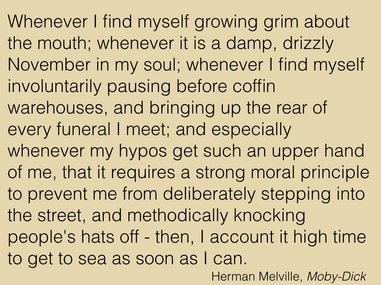 I modeled this approach using one of my favorite sentences: Ishmael’s reflection in chapter one of Moby-Dick. 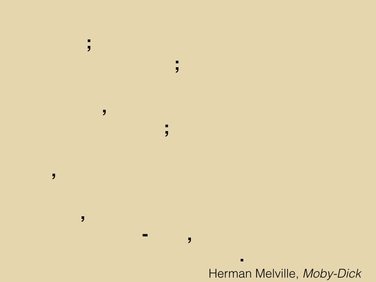 and then showing what I notice when I focus on structure… 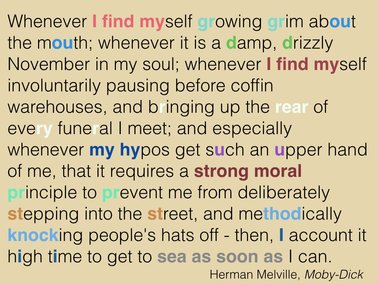 ...and when I focus on musicality… 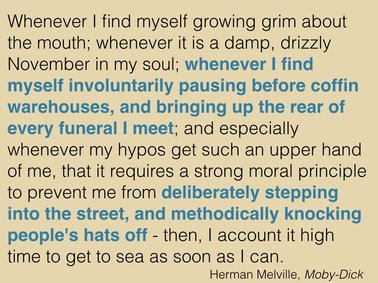 ...and content… I found through this approach that my students were actually engaging with the text in a way I hadn’t seen when teaching the whole novel in a traditional manner. Students who typically resorted immediately to finding the “important stuff” online now moved slowly and carefully through their assigned pages, reflecting on sentences and critically assessing the beauty of others’ discoveries. Most surprisingly, though, was that several students asked me if they could read beyond their hundred pages, to which I of course assented. Here are some of the sentences that my students singled out as beautiful, with excerpts from their analyses beneath each (To Kill a Mockingbird text in bold/quotes, student responses in italics): “The feeling grew until the atmosphere in the courtroom was exactly the same as a cold February morning, when the mockingbirds were still, and the carpenters had stopped hammering on Miss Maudie’s new house, and every wood door in the neighborhood was shut as tight as the doors of Radley Place.” You can picture what the character is talking about. You feel the still air and think of something that reminds you of this moment for the character. The sentence uses the “oo” sound to make the sentence more repetitive. The sentence looks smooth. There aren’t too many ups and downs with the letters which makes it look like it would flow. “Our battles were epic and one-sided.” Epic was a weird word choice because I feel like it only used for like monster trucks or a back flip. “Giant monkey puzzle bushes bristled on each corner, and between them an iron hitching rail glistened under the street lights.” This sentence is just a mosh pit of words, some that rhyme and some that don’t. Some that rhyme are “bristled” and “glistened.” The words in this sentence don't flow very well but that makes it sound out of this world. “That proves something- that a gang of wild animals can be stopped, simply because they’re still human." You hear the hope in the middle of the sentence with the words “can be stopped” The word can gives the reader hope that they have a chance to calm the mob down and stop the madness. 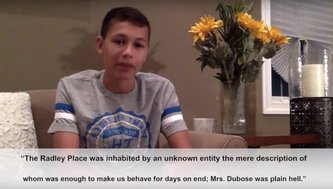 Finally, they created and shared a video in which they taught, John Green Crash Course-style, the sentence to their fellow Beautiful Sentence-lovers… In anticipating the Fake Reading approach as the norm, rather than the exception, to student reading approaches, I essentially took away a weapon on which students had become overly reliant. Fake Reading, in its stark, Machiavellian efficiency, is sadly an approach that works for most English students; we must respond in turn to this strategy, rather than futilely persisting with an outdated methodology. I encourage you to join me, and any other willing educators, as we wage war on Fake Reading. I (@MrMorone) will be hosting the June #CELchat on reading instructional strategies, both fake and authentic, on Wednesday, June 7. Additionally, I will be sharing, alongside the aforementioned Gerard Dawson, author of Hacking Literacy, at the 2017 NerdCampNJ at Chatham High School in Chatham, New Jersey on Saturday, May 20, which is being organized by fellow “CELmate” Oona Abrams. I hope to see you there. 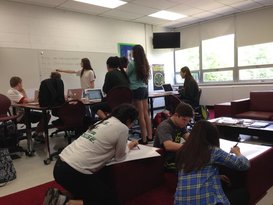 Sophomores work on strengthening different skills in an "open" class period. Sophomores work on strengthening different skills in an "open" class period. πόλλ' οἶδ' ἀλώπηξ, ἀλλ' ἐχῖνος ἓν μέγα (“A fox knows many things, but a hedgehog one important thing”) Archilochus, 600 BCE Greek poet and hirsute chap Archilochus coined the term; Isaiah Berlin framed his eloquent criticism of Tolstoy with it; even statistician-to-the-stars Nate Silver borrowed it for his site’s logo. We are, one way or another, foxes or hedgehogs. The criteria for these terms has changed to fit different philosophical scenarios, but ultimately the message is consistent: foxes approach new situations as unique and rely on fluid intelligence; hedgehogs approach new situations as familiar and rely on previous experience. To put it even more bluntly: foxes rely on ingenuity; hedgehogs, instinct. I’ve been fascinated by this thought since I read Berlin’s essay, despite my hesitation towards binary categorization. Could it be applied to the classroom? Of course, even the aforementioned scholars acknowledge that a “true” hedgehog or fox is rare; we all assume characteristics of both depending on the situation. However, I think it’s safe to say that we lean hard in one direction or another most of the time. This categorization also makes for a fun parlor game: The 2016 Yankees, hedgehogs; the 2016 Cubs, foxes. Beyonce: fox; Adele: hedgehog. Luke is a hedgehog; Han is a fox. Tyrion Lannister, Sansa Stark, and Daenerys "Mother of Dragons" Targaryen are foxes; Jon Snow, Jorah Mormont, and Brienne of Tarth are hedgehogs. Arya Stark wanted to be a fox but knew deep down she was a hedgehog. Cersei Lannister pretends to be a hedgehog but is clearly a fox. (How many more months??) But what about the typical classroom today? Before we can address that question, let’s establish, for the sake of this exercise, what foxes and hedgehogs look like in our student population. It's important to note that this is not an argument as to whether our students are naturally more inclined towards one side of the spectrum than the other; rather, this is a reflection on how out students have adjusted their approach to survive and succeed within the constructs of our educational system. Our students as people are almost certainly hybrids of both, but it is my belief that our students as students have developed an academic approach grounded in one of these two philosophical approaches. Again, as with the contemporary examples above, very few students would identify as extreme foxes or hedgehogs (although I was well-acquainted with a certain extreme hedgehog back in my day), but they would most likely subscribe to one of these two approaches. The “Hedgehog” student…
The “Fox” student…
I don’t think it’s too much of a stretch to say that throughout the vast history of American public education, the system was designed for little hedgehogs: “This is what a classroom looks like; here is how to get a good grade; here is how to behave; keep your head down and follow directions.” The homogeneity of classroom experiences both within subject areas and throughout entire school buildings conditioned students to equate physical, philosophical, and curricular uniformity with How Learning Happens in a broader sense. “School”, as has been often discussed, was first and foremost a vessel for societal and economic conformity, and was designed as such. Either hedgehogs entered school and found a system that was conducive to their pre-existing mentality, or students were molded into hedgehogs through the experience. But if you haven’t noticed, it’s hard out there for a hedgehog lately. Global economic flattening, a lethargic manufacturing economy, the evaporation or emigration of entire industrial sectors, and the allure of hiring labor from emerging markets has rendered many rule-following, hard-working hedgehogs unnecessary. As Glenn Reynolds writes in The New School: How the Information Age Will Save American Education from Itself, "How many 19th century business models do you see flourishing, here in the 21st?" The populist angst of this most recent election cycle--on both the left and right--is in large part a result of the betrayal of the promise educational institutions made to complicit students: "Do what we tell you, get good grades, and stay out of trouble, and you’ll have your American Dream." Instead, foxes rule the realm. The sharing economy and rise of creative technology has created a boon for adaptive, nontraditional problem-solving. Entire industries, such as the livery and hotel sectors, have been upended seemingly overnight by a few lines of code. Robots invest your money, websites buy your groceries, and soon, drones will deliver your toothpaste. Schools that genuinely wish to prepare their students for post-academic success must recognize this fact and adjust accordingly. Additionally, hedgehogs have never been more vulnerable. Fake news sites, near-subliminal product placement in television and film, and echo chambers on college campuses have reinforced the "hedgehogian" approach of receiving all statements as fact, especially when these statements confirm one's own biases. A recent Pew report found that 62% of American adults get their news primarily from social media; even more damning: 44% get their news primarily from Facebook, which has recently faced renewed criticism that its passivity with regard to bogus "news stories" has unfairly swayed its users' beliefs. By maintaining the belief that "since it looks like news, it must be true," individuals have allowed private interests to compromise their understanding of the world. The ubiquity and immediacy of the Internet cannot be understated as well, specifically with regard to its role in the contemporary classroom. The classroom teacher cannot fall back to his or her role as dispenser of information any longer; those that do are undoubtedly setting themselves up for irrelevancy. As the late, great comedian Mitch Hedberg once quipped, “The depressing thing about tennis is that no matter how good I get, I'll never be as good as a wall.” Veteran high-school English teacher Michael Godsey recently reflected on his advice to an aspiring educator in his powerful Atlantic article, “The Deconstruction of the K-12 Teacher”, saying "[I]f you want to be a teacher, you better be a super-teacher." He continues: “When I did some research to see if it was just me sensing this transformation taking place, I was overwhelmed by the number of articles all confirming what I had suspected: The relatively recent emergence of the Internet, and the ever-increasing ease of access to web, has unmistakably usurped the teacher from the former role as dictator of subject content. These days, teachers are expected to concentrate on the "facilitation" of factual knowledge that is suddenly widely accessible. 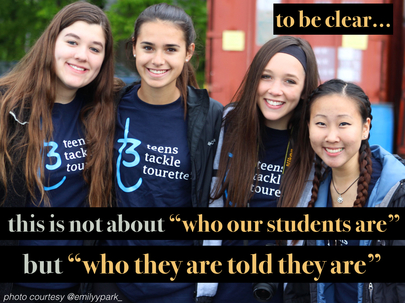 To be clear: there is nothing “wrong” or “bad” about being a hedgehog. I am a hedgehog about a lot of things, most glaringly when I’m driving. No, Google, I don’t care if that route shaves seven minutes off of my trip; I don’t want to take a different exit. Accordingly, there is nothing inherently “right” or “good” about foxiness; it is simply a different way of looking at the world. What is undeniable is that our world is following an accelerating trajectory towards a fox-centric viewpoint, and we as educators should be in the business of preparing our students for a world that exists and will exist, not one that has been supplanted by innovation. Effective instruction is predictive, not nostalgic. In my class, there are no letter grades; there are no assigned seats (but there is a sofa); you can read the books in any order you’d like; I don’t teach every student at the same time; you don’t “do assignments”, you “demonstrate skills”; you assign yourself homework (if you want); there are no deadlines, other than the last day of the school year (and even that is philosophically problematic...*another post for another day*); you can write about whatever you want; you can read whatever you want; there is no extra credit; you set your own schedules; you choose when and how to show me that you learned something; you are allowed to submit work as many times as you’d like, and only the strongest work counts. As you would imagine, hedgehogs struggled mightily with this approach. Gone were the familiar, comforting structures of a “typical” English class. No longer was there the promise that the approach that got students to this point would translate to the new environment. In fact, I made this explicit on day one: we are doing something different here. The few foxes in the room ran with it, grabbing books from the shelves and crafting personal narratives within the first few weeks. The more adaptive hedgehogs soon followed suit, albeit with a healthy (and welcome) dose of skepticism. But still, months in, there were several hedgehogs who refused to budge. In a deep way, I admired their persistence: witnessing a student so adamant about anything is something to celebrate; however, I knew (and perhaps they did as well), that this refusal of and reluctance towards authentic, flexible, adaptive learning would not only hurt them in this school year, it could potentially compromise their future scholarship, employment, and overall happiness as well. This new classroom approach was, to these hedgehogs, an affront to the assumed dynamic between teacher and student. It placed new demands of transparency and measurable growth on students. It eliminated the grade inflation often present in environments with class participation and communal group work grades. In short, this class defines student success differently: not as one who “does school” but as one who demonstrates growth in learning. It's entirely expected that most students would resist this approach; when we design our classrooms in the mold of our inherited educational system--that of conformity, uniformity, and subordinance--any variation invokes the anxiety of the unknown. I was a textbook hedgehog student: I wanted to know what to do to get the A, exactly how long my paper should be, and which topics would be on the test. Nothing gave me more trepidation than walking into an English class to see the desks arranged in a giant circle. This fear was borne not out of a biological resistance to the philosophy but an entirely understandable sense of unease. Without belaboring the point, we are presently seeing a resistance to immediate and comprehensive societal change playing out at the national and global level. While the specifics may be different, this is behaviorally very similar to the response to fundamentally changing the classroom dynamic. English teachers are especially guilty of this: often the "foxiest" lessons happen in their rooms. However, the only way to normalize this approach is to treat it not as a "fun thing we're trying out today" but as the "Way We Do Things Here." Regardless of whether our students are naturally more like the hedgehog or the fox, when a system historically presents one approach as implicitly correct, the individual has only two options: rebel and fail, or conform to survive (call it "institutional adaptation.") No wonder so many of our peers shudder when they reflect on their high school experiences: they barely made it out alive! Again, the takeaway of this should not be that foxy learning is in some way “better” or “more correct” than hedgy learning. Assigning a qualitative value to the two dimensions is irrelevant; ultimately, students should be able to adapt to and thrive in both types of environments. What is apparent, and becoming more and more evident every day, is that while there is no way to predict the future, we can infer based on myriad economic indices that the vast majority of the career paths that our students will want to follow prioritize an adaptive, flexible, and curious approach. Tragically, many of the careers we are implicitly and, in many cases, unconsciously preparing them for will by that time be automated, outsourced, or extinct. To deprive students of this exposure in the interest of familiarity is dangerous for both their short- and long-term success. We want all of our little animals, the foxes and hedgehogs alike, to thrive in the wild; our practice should ensure that they are exposed to both environments and are given the tools and experiences necessary to succeed, now and throughout their lives. Note: This post is the topic of my upcoming NCTE/CEL presentation "The Hedgehog and the Fox: Lessons Learned from a Year in the Open Classroom" on Sunday, November 20th, 2016 at 4:30 pm in the Georgia World Conference Center room A404. I encourage you to check out the entire conference program; hopefully I'll see you there! We’ve all seen it: the student staring at the blank GoogleDoc on their laptop, or the empty lined paper in front of them, desperately willing the words to arrive. One of my former students put it best:
“That must be why they call it a cursor; it feels like every time it blinks on the screen it’s cursing at me.” Granted, there are some students who just flat-out refuse to write; those students to whom the act of writing anything for school has already been equated directly with pain and suffering. We will talk about those students in due time. Today, I’d like to address the students who have been crippled by the need for “first draft perfection.” First Draft Perfection Syndrome (FDPS) is chronic among “high performing” and “ambitious” high schoolers, those tracked early into gifted and accelerated programs, but can appear within any student population. The causes of this ailment are manifold, but can ultimately be traced back to one root: frequent exposure to "high-stakes" writing environments. This approach, unfortunately, often clashes with the philosophical rhetoric we espouse regarding writing in general. “Writing is a process of continual refinement and improvement,” we say, “all the greats went through countless drafts...do you think Shakespeare just sat down and wrote Hamlet?!” The message that’s conveyed with this approach, however, is that fearless drafting is something that’s done out there; in here those rules don’t apply. I want to be clear: locking students into permanent grades on their first attempt at writing is contrary to the nature of recursive, reflective practice; it discourages a respect for and love of writing in general. This is not to say, of course, that first drafts can’t or shouldn’t be assessed; in fact, taking a student’s pulse via their first attempt at a piece of writing is an essential formative assessment approach. But to treat a first draft as the be-all and end-all of the writing process establishes a dangerous mentality: don’t fly too close to the sun, young Icarus, or you will get burned. This approach tacitly encourages “safe” writing, and as a result, students are deprived of opportunities to attempt more advanced writing techniques. I am of the rather unpopular belief that the top ten percent of our student population stagnates, on average, as much or more so than the bottom ten percent. The reason we don’t notice is because the evidence for this is in many ways obfuscated by arbitrary “ceilings” placed on high-performing students through the “far left” column of traditional writing rubrics. In short, “honors-level” students learn early in their academic careers what constitutes “A-level” writing, and in turn perpetually write to that level, rarely venturing outside the safety of that assumed paradigm. The fact that these students continue to receive high grades on their writing speaks less to their growth than it does to their systemic conformity and survival instincts. Why attempt something new, they rightfully rationalize, when this safe approach has garnered them the grades they desire? By presenting and reinforcing an initial attempt at a piece of writing as just that: the first, awkward step in a long process, we not only contextualize the role of a writer but emphasize the metacognitive aspects of recursive writing as well. This cannot be done in a grading model that treats first (or any) drafts as final submissions; nor can it be accomplished in a classroom environment that shuttles students from point to point regardless of individual proficiency. Failure is not solely the domain of “weak” students-- it must be destigmatized and presented as a necessary step on the path to any skill development. In giving students the opportunity to reflect on just how imperfect their first drafts are, and eliminating the negative reinforcement (or conversely, the misleading grade inflation) of first attempts in general, we provide students with a safe environment for candid self-awareness, acknowledgement of skill-deficit, and focused goal-setting for future drafts. This approach also untethers teachers from the inherent guilt in, and avoidance of, grading first submissions for what they actually are instead of what they will do to a student’s average. By supporting “conscious drafting”, we both make our students more aware of the writing process and give ourselves the freedom to assess more authentically. My Ten Suggestions for Encouraging “Conscious Drafting” in the ELA Classroom
If we truly want our students to view writing as a continual exercise in improvement, we owe them the opportunity to actually demonstrate that skill in an environment that supports their efforts, both philosophically and systemically. |
AuthorMatt Morone (@MrMorone) is a high school English teacher, NCTE/CEL Member-at-Large & NJ state liaison, #CELchat organizer, faculty advisor to Outside/In literary magazine, 2016 Princeton Distinguished Secondary Teacher of the Year, constant reader, novice blogger, avid music fan, and sandwich aficionado. Archives
January 2019
Categories
All
Ed Blog Friends This work is licensed under a Creative Commons Attribution-NonCommercial-NoDerivatives 4.0 International License. |
Proudly powered by Weebly

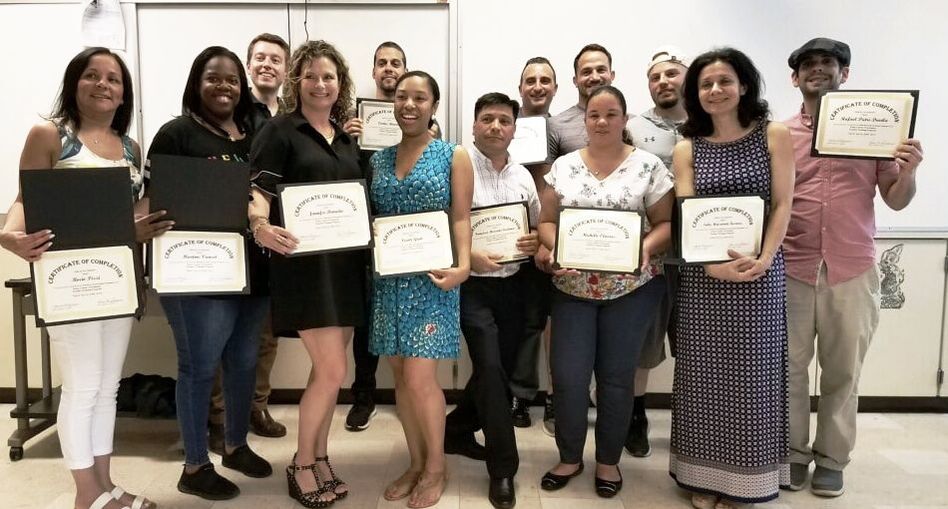
 RSS Feed
RSS Feed